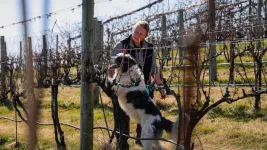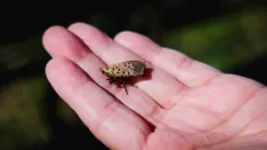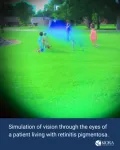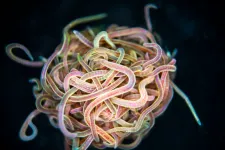(Press-News.org) From New York to North Carolina and as far west as Illinois, the invasive spotted lanternfly is causing chaos in many states where agricultural and forestry industries are essential to the economy. It has been estimated that crops and forest production losses caused by insects and pathogens are close to $40 billion a year.
Spotted laternflies, native to mainland China, prey upon 70-plus host plant species, stealing their nutrients with their piercing snouts, called stylets. They are often characterized as “hitchhikers” for their ability to move long distances through human-assisted movement. Envision logging trucks traveling back and forth across the country with a few unwelcome pesky passengers braced to the back.
Officials in infested states have brainstormed different approaches to stop the spread of this deadly leafhopper.
Stomp, squash, or smash the dastardly bug, they say.
Now, researchers in Virginia Tech’s College of Agriculture and Life Sciences are experimenting with a new approach and calling upon dogs in the fight against the spotted lanternfly.
With a four-year, $475,000 grant from the U.S. Department of Agriculture-Agriculture and Food Research Initiative, Erica Feuerbacher, an associate professor of applied animal welfare and behavior in the School of Animal Sciences, and Mizuho Nita, a Virginia Cooperative Extension specialist and an associate professor in the School for Plant and Environmental Sciences, have partnered with researchers at Texas Tech University to combat both the spotted lanternfly and the deadly fungal disease powdery mildew with the help of canines and their citizen-scientist counterparts.
The project, unofficially called the Canine Citizen Science Study, began two years ago in an olfactory lab at Texas Tech and has recently expanded to the East Coast, where Feuerbacher and assistants are asking dog owners to unite and utilize their pets’ scent work skills to sniff out spotted lanternfly eggs.
The nose, knows
Flint is an 8-year-old border collie. He is energetic, playful, and very well-trained, thanks to the efforts of his talented owner and trainer, Sally Dickinson, a doctoral candidate in the School of Animal Sciences and a student of Feuerbacher’s.
Both women share an affinity for four-legged animals, especially dogs. Feuerbacher has a vested interest in dog welfare and behavior, while Dickinson has a strong background in training dogs for odor detection. Flint has been trained in emergency situations as a cadaver dog. More recently, he’s become an expert at finding spotted lanternfly eggs.
For decades, dogs and their impeccable noses, which possess up to 300 million olfactory receptors, have been used to detect missing people, narcotics, and explosives. Nose work has also become an increasingly popular dog sport, Feuerbacher said.
“Every day, average dogs are competing and finding these scents, and that speaks to their potential ability to detect ecologically and agriculturally relevant targets,” Feuerbacher said.
On a crystal-clear afternoon, Flint showed off his impressive sense of smell at the Alson H. Smith Jr. Agricultural Research and Extension Center in Winchester. The center is well-known for its contributions to the commercial fruit industry, including wine grape research. Dripping with clusters of sugary fruit, grapevines are especially prone to spotted lanternflies.
Insects have a sweet tooth, too, supposedly.
This was Flint’s first foray into the field. Up until this point, Dickinson had only trained him at home using spotted lanternfly egg samples.
“To train a dog to detect an odor, we use a pairing mechanism,” Dickinson said. “The dog has to learn that a particular odor is of value to them. We present the odor and pair that with something that is pleasurable or edible – whatever is reinforcing to the dog. That creates a message in the dog’s mind that, ‘If I look for that thing, and I find it, something really good happens in my life.’”
For Flint, the reward was handfuls of treats as he worked his way through the grapevines, sniffing, stopping, and even pointing with his paw when lines of tiny eggs were detected.
Nita, who operates a grape disease management research and Extension lab at the Alson H. Smith Jr. Agricultural Research and Extension Center, watched from afar with excitement.
He saw firsthand the detriment of the spotted lanternfly. He recalls flying the drone when the fly was first detected at the research center about two years ago.
“There were thousands,” he said.
As part of the canine detection project’s partnership with Texas Tech, Nita sends egg samples to the university’s Canine Olfaction Research and Education Laboratory. Under the leadership of Associate Professor Nathan Hall, the lab has conducted multiple behavioral and olfactory research studies. Nita and Hall have been at the forefront of the study for the past two years.
Early detection is critical to stopping and destroying the lanternfly, Nita said. Their eggs are very small and often laid on the underside of plants. As they develop into adults, the flies start feeding on the plants and stealing their nutrients. What they don’t digest, they discharge on the leaves of the plant, inviting another issue: mold.
“Naturally, my fear is the risk to the quality of the grapes and the wines they produce,” Nita said. “I worry that growers will be overusing insecticides. While they have proved effective in killing the spotted lanternfly, they also cause harm to beneficial insects; therefore, it may bring other issues to our crops.”
Nita said he is hopeful that with early detection, the spotted lanternfly will be effectively managed, and thus, it will slow down the rate of spread to further south, the path they are currently projected. And as the “dog detectives” master their craft, the research group will be challenging them to detect additional harmful predators, like the deadly plant pathogen, powdery mildew.
Stomp, squash, smash, and sniff the spotted lanternfly
Partnering with the National Association of Canine Scent Work, Feuerbacher and Dickinson will recruit teams of dogs and their owners to help detect spotted lanternfly eggs.
“This is a great opportunity for people to have fun with their dogs while also contributing back to their communities in a meaningful way,” Feuerbacher said.
Dickinson encourages dog owners to ignore the myths that certain dog breeds aren’t suitable for scent detection.
“There is plenty of research out there that indicates that all dogs can smell,” she said. “Maybe the ‘smooshy’-nosed dogs aren't as good in the really hot weather to work for five hours straight, but they can definitely do it.”
Research has shown, Dickinson said, that scent training may also contribute to positive behavioral changes in dogs.
“At the completion of the study, we hope to have a strong network of handlers able to locate spotted lanternfly egg masses as a proof-of-concept program, with the intent to create an enduring citizen-based detection program for this and other invasive species,” Dickinson said. “Put your training skills to work and help protect our vineyards, fruit orchards and flower gardens.”
END
Calling all canines: Help sniff out the dangerous spotted lanternfly
2023-04-27
ELSE PRESS RELEASES FROM THIS DATE:
AGS honors expert & emerging geriatrics leaders at 2023 Annual Scientific Meeting (#AGS23)
2023-04-27
New York (April 27, 2023) – The American Geriatrics Society (AGS) annually honors researchers, clinicians, educators, and emerging health professionals who have made outstanding contributions to high-quality, person-centered care for older adults. This year’s award recipients include 19 leaders representing the breadth of medical disciplines championing care for us all as we age.
Clinical Student Research Award
Matthew Ryan Cosmai
Clinician of the Year Award
Shelley R. McDonald, DO, PhD
David H. Solomon Memorial Public Service Award
Alan Lazaroff, ...
Plastic particles themselves, not just chemical additives, can alter sex hormones
2023-04-27
Amid rising evidence that additives designed to improve plastics also disrupt sex hormones, a Rutgers laboratory trial shows that plastic itself can do likewise when inhaled at moderate levels.
Previous studies focused on chemicals such as bisphenol-A (BPA) that make plastics stiffer or more flexible. These findings spurred ongoing efforts to find safer plastic additives.
The Rutgers study showed that microscale and nanoscale particles (MNPs) of polyamide, a common plastic better known as nylon, produced endocrine-disrupting ...
ATS 2023 International Conference announces late-breaking clinical trials
2023-04-27
April 27, 2023 – One of the most highly-anticipated events at the ATS 2023 International Conference, which kicks off May 19, is the “Breaking News: Clinical Trial Results in Pulmonary Medicine.” Taking place on Monday, May 22, the series of presentations will focus on the latest regarding COPD and asthma treatment.
Register now to hear these presentations live. A question-and-answer period will follow all presentations:
Seralutinib Treatment in Adult Subjects with Pulmonary Arterial Hypertension: Results from the TORREY Study
Effect of Ensifentrine, a Novel PDE3 and PDE4 Inhibitor, on Lung Function, Symptoms and Exacerbations in Patients with COPD: ...
In yeast, altering genetic circuitry that controls how an aging cell dies enhances longevity
2023-04-27
Engineering a synthetic oscillator that cycles between the two deterioration pathways that lead to cell death can slow aging in yeast cells, increasing their longevity by more than 80%, a new study reports. The findings represent a proof-of-concept example of using synthetic biology to reprogram the cellular aging process. Given that the underlying aging pathways are conserved, the findings may one day enable the design of synthetic gene circuits that promote longevity in more complex organisms. Cellular aging is a fundamental and complex biological process ...
Backpropagation training achieved in photonic neural network
2023-04-27
Neural networks made from photonic chips can be trained using on-chip backpropagation – the most widely used approach to training neural networks, according to a new study. The findings pave the way toward developing optically driven and energy-efficient machine learning technologies that reduce both the carbon footprint and costs of AI computation. Neural networks (NNs) are an approach to machine learning conceptually inspired by the biology of the brain and have become a mainstay in various modern scientific and commercial AI technologies, including the widely discussed ChatGPT architectures. ...
Comparing the genes of 240 species of mammals—and one famous dog—offers a powerful new approach for understanding biology and evolutionary history
2023-04-27
Ever since scientists first read the complete genetic codes of creatures like fruit flies and humans more than two decades ago, the field of genomics has promised major leaps forward in understanding basic questions in biology.
And now comes a major installment of that promise. In what Howard Hughes Medical Institute Investigator and HHMI Professor Beth Shapiro calls a treasure trove of research, more than 150 researchers from 50 institutions are publishing 11 different papers in the April 28, 2023, issue of Science. The research brings new insights from the Zoonomia Project, an unprecedented collaborative effort led by Elinor Karlsson, director of the Vertebrate Genomics ...
Pulling the plug on viral infections: CRISPR isn’t just about cutting
2023-04-27
CRISPR claimed scientific fame for its ability to quickly and accurately edit genes. But, at the core, CRISPR systems are immune systems that help bacteria protect themselves from viruses by targeting and destroying viral DNA and RNA. A new study published in Science reveals a previously unrecognized player in one such system – a membrane protein that enhances anti-viral defense – simultaneously broadening our understanding of and raising more questions related to the complexities of CRISPR.
Uncovering New Clues about CRISPR
CRISPR systems consist of two major components – a guide RNA that targets a specific viral DNA or RNA sequence and a Cas enzyme ...
Unraveling the mathematics behind wiggly worm knots
2023-04-27
For millennia, humans have used knots for all kinds of reasons — to tie rope, braid hair, or weave fabrics. But there are organisms that are better at tying knots and far superior — and faster — at untangling them.
Tiny California blackworms intricately tangle themselves by the thousands to form ball-shaped blobs that allow them to execute a wide range of biological functions. But, most striking of all, while the worms tangle over a period of several minutes, they can untangle in mere milliseconds, escaping at the first sign of a threat from a predator.
Saad Bhamla, assistant ...
Information ‘deleted’ from the human genome may be what made us human
2023-04-27
New Haven, Conn. — What the human genome is lacking compared with the genomes of other primates might have been as crucial to the development of humankind as what has been added during our evolutionary history, according to a new study led by researchers at Yale and the Broad Institute of MIT and Harvard.
The new findings, published April 28 in the journal Science, fill an important gap in what is known about historical changes to the human genome. While a revolution in the capacity to collect data from genomes ...
Mammalian evolution provides hints for understanding the origins of human disease
2023-04-27
CHAPEL HILL, N.C. – Hundreds of scientific studies have been conducted over the years to find the genes underlying common human traits, from eye color to intelligence and physical and mental illnesses.
Patrick Sullivan, MD, FRANZCP, the Yeargan Distinguished Professor of Psychiatry and Genetics at the UNC School of Medicine, and the Psychiatric Genomic Consortium have produced a new packet for the journal Science, to give researchers another way to understand human disease, using the power of evolutionary genomics.
“This is a tool that can give us a lot of important hints about human disease,” ...





